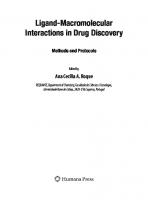Biopolymers in Food Colloids: Thermodynamics and Molecular Interactions 900417186X, 9789004171862
312 101 193KB
English Pages 369 [421] Year 2010
Table of contents :
Cover Page......Page 1
Title Page......Page 2
ISBN 9789004171862......Page 3
Acknowledgements......Page 7
Preface......Page 4
Table of Contents......Page 8
1. Significance of Biopolymer Interactions in Context of Nanoscience and Nanotechnology......Page 14
Bibliography......Page 37
2.1 Bioactive Food Ingredients......Page 43
2.2 Encapsulation Processes and Delivery Systems......Page 59
2.3 Biopolymer-Based Delivery Vehicle Ingredients......Page 63
2.3.1 Protein Gels and Gel Particles......Page 70
2.3.2 Biopolymers as Emulsifying Wall Material for Encapsulation......Page 72
2.3.3 Mixtures and Complexes of Proteins with Polysaccharides as Delivery Vehicles......Page 75
2.3.4 Food-Grade Self-Assembled Biopolymer Particles......Page 77
Concluding Remark......Page 80
Bibliography......Page 81
3. The Thermodynamic Approach: Its Importance for Understanding and Manipulating the Molecular Interactions of Biopolymers......Page 90
3.1 Two-Component Solutions: Biopolymer + Solvent......Page 93
3.2 Three-Component Solutions: Biopolymer_1 + Biopolymer_2 + Solvent......Page 97
3.3.1 Surface Behaviour of Biopolymers......Page 107
3.3.2 Interactions between Colloidal Particles Covered by Biopolymer......Page 110
Concluding Remark......Page 118
Bibliography......Page 119
4. Energy and Character of Main Types of Biopolymer Interactions......Page 128
4.2 Electrostatic Interactions......Page 136
4.4 Hydrogen Bonding......Page 137
4.6 Excluded Volume ('Steric') Interactions......Page 138
4.8 Covalent Bonding......Page 139
Concluding Remarks......Page 140
Bibliography......Page 141
5.1 Basic Thermodynamic Functions and Parameters......Page 142
5.2.1 Osmometry......Page 146
5.2.2 Laser Light Scattering......Page 149
5.2.3 Sedimentation Equilibrium......Page 156
5.2.4 Self-Interaction Chromatography......Page 158
5.2.5 Isothermal Titration/Mixing Calorimetry......Page 159
Bibliography......Page 160
6. Self-Assembly of Food Biopolymers for the Development of Health-Promoting Properties of Food Colloids......Page 166
6.1 Self-Assembly due to Specific Kinds of Biopolymer Interactions......Page 167
6.1.1 Caseins......Page 168
6.1.2 Whey Proteins......Page 177
6.1.3 Polysaccharides......Page 182
6.2 Surfactant-Based Self-Assembly of Proteins......Page 187
6.3 Surfactant-Based Self-Assembly of Polysaccharides......Page 201
6.4 Manipulation of Food Colloid Properties through Biopolymer Self-Assembly......Page 205
Concluding Remark......Page 229
Bibliography......Page 230
7.1.1 The Nature of Thermodynamically Unfavourable Interactions......Page 243
7.1.2 The Phenomenon of Segregative Phase Separation - 'Simple Coacervation'......Page 244
7.1.3.1 Adsorption Behaviour......Page 252
7.1.3.4 Stability of Emulsions with Respect to Flocculation......Page 256
7.1.3.5 Gelation of Biopolymers in Mixed Aqueous Solutions......Page 262
7.2.1 The Nature of Thermodynamically Favourable Interactions......Page 268
7.2.2 Physico-Chemical Features of 'Complex Coacervation'......Page 271
7.2.3 Thermodynamically Favourable Interactions Involving Neutral Polysaccharides......Page 276
7.2.4.1 Adsorption Behaviour......Page 277
7.2.4.2 Emulsifying Properties and Emulsion Droplet Size......Page 281
7.2.4.4 Stability of Emulsions with Respect to Flocculation......Page 282
7.2.4.5 Structure of Adsorbed Layers of Interacting Biopolymers - Effect of the Order of Addition to the Interface......Page 286
7.2.4.6 Gelation in Mixed Biopolymer Systems......Page 295
7.2.5 Application of Biopolymer Complexes for Encapsulation......Page 296
7.B Impact of Covalent Protein-Polysaccharide Conjugates on Structure and Stability of Colloidal Systems......Page 299
Concluding Remarks......Page 304
Bibliography......Page 305
Introduction to Part Four......Page 318
Bibliography......Page 320
8. Biopolymer Interactions in Adsorbed Layers: Relationship to Properties of Food Colloids......Page 322
8.1.1 Self-Association at Interfaces......Page 324
8.1.2 Segregation in Mixed Protein Layers......Page 329
8.2 Proteins + Surfactants at Interfaces......Page 334
8.2.1 The Competitive Displacement Mechanism......Page 337
8.3 Proteins + Polysaccharides at Interfaces......Page 346
8.3.1 Complexation and Associative Interactions......Page 347
8.3.2 Phase Separation and Segregative Interactions......Page 350
8.4 Particles at the Interface of a Phase-Separated Mixed Biopolymer System......Page 351
8.5 Enzymatic Hydrolysis in the Presence of Biopolymer Adsorbed Layers......Page 353
Concluding Remarks......Page 355
Bibliography......Page 356
A......Page 366
B......Page 370
C......Page 371
D......Page 378
E......Page 381
F......Page 384
G......Page 386
H......Page 389
I......Page 391
K......Page 394
L......Page 395
M......Page 397
N......Page 399
O......Page 401
P......Page 402
R......Page 408
S......Page 409
T......Page 417
V......Page 419
W......Page 420
Z......Page 421
Cover Page......Page 1
Title Page......Page 2
ISBN 9789004171862......Page 3
Acknowledgements......Page 7
Preface......Page 4
Table of Contents......Page 8
1. Significance of Biopolymer Interactions in Context of Nanoscience and Nanotechnology......Page 14
Bibliography......Page 37
2.1 Bioactive Food Ingredients......Page 43
2.2 Encapsulation Processes and Delivery Systems......Page 59
2.3 Biopolymer-Based Delivery Vehicle Ingredients......Page 63
2.3.1 Protein Gels and Gel Particles......Page 70
2.3.2 Biopolymers as Emulsifying Wall Material for Encapsulation......Page 72
2.3.3 Mixtures and Complexes of Proteins with Polysaccharides as Delivery Vehicles......Page 75
2.3.4 Food-Grade Self-Assembled Biopolymer Particles......Page 77
Concluding Remark......Page 80
Bibliography......Page 81
3. The Thermodynamic Approach: Its Importance for Understanding and Manipulating the Molecular Interactions of Biopolymers......Page 90
3.1 Two-Component Solutions: Biopolymer + Solvent......Page 93
3.2 Three-Component Solutions: Biopolymer_1 + Biopolymer_2 + Solvent......Page 97
3.3.1 Surface Behaviour of Biopolymers......Page 107
3.3.2 Interactions between Colloidal Particles Covered by Biopolymer......Page 110
Concluding Remark......Page 118
Bibliography......Page 119
4. Energy and Character of Main Types of Biopolymer Interactions......Page 128
4.2 Electrostatic Interactions......Page 136
4.4 Hydrogen Bonding......Page 137
4.6 Excluded Volume ('Steric') Interactions......Page 138
4.8 Covalent Bonding......Page 139
Concluding Remarks......Page 140
Bibliography......Page 141
5.1 Basic Thermodynamic Functions and Parameters......Page 142
5.2.1 Osmometry......Page 146
5.2.2 Laser Light Scattering......Page 149
5.2.3 Sedimentation Equilibrium......Page 156
5.2.4 Self-Interaction Chromatography......Page 158
5.2.5 Isothermal Titration/Mixing Calorimetry......Page 159
Bibliography......Page 160
6. Self-Assembly of Food Biopolymers for the Development of Health-Promoting Properties of Food Colloids......Page 166
6.1 Self-Assembly due to Specific Kinds of Biopolymer Interactions......Page 167
6.1.1 Caseins......Page 168
6.1.2 Whey Proteins......Page 177
6.1.3 Polysaccharides......Page 182
6.2 Surfactant-Based Self-Assembly of Proteins......Page 187
6.3 Surfactant-Based Self-Assembly of Polysaccharides......Page 201
6.4 Manipulation of Food Colloid Properties through Biopolymer Self-Assembly......Page 205
Concluding Remark......Page 229
Bibliography......Page 230
7.1.1 The Nature of Thermodynamically Unfavourable Interactions......Page 243
7.1.2 The Phenomenon of Segregative Phase Separation - 'Simple Coacervation'......Page 244
7.1.3.1 Adsorption Behaviour......Page 252
7.1.3.4 Stability of Emulsions with Respect to Flocculation......Page 256
7.1.3.5 Gelation of Biopolymers in Mixed Aqueous Solutions......Page 262
7.2.1 The Nature of Thermodynamically Favourable Interactions......Page 268
7.2.2 Physico-Chemical Features of 'Complex Coacervation'......Page 271
7.2.3 Thermodynamically Favourable Interactions Involving Neutral Polysaccharides......Page 276
7.2.4.1 Adsorption Behaviour......Page 277
7.2.4.2 Emulsifying Properties and Emulsion Droplet Size......Page 281
7.2.4.4 Stability of Emulsions with Respect to Flocculation......Page 282
7.2.4.5 Structure of Adsorbed Layers of Interacting Biopolymers - Effect of the Order of Addition to the Interface......Page 286
7.2.4.6 Gelation in Mixed Biopolymer Systems......Page 295
7.2.5 Application of Biopolymer Complexes for Encapsulation......Page 296
7.B Impact of Covalent Protein-Polysaccharide Conjugates on Structure and Stability of Colloidal Systems......Page 299
Concluding Remarks......Page 304
Bibliography......Page 305
Introduction to Part Four......Page 318
Bibliography......Page 320
8. Biopolymer Interactions in Adsorbed Layers: Relationship to Properties of Food Colloids......Page 322
8.1.1 Self-Association at Interfaces......Page 324
8.1.2 Segregation in Mixed Protein Layers......Page 329
8.2 Proteins + Surfactants at Interfaces......Page 334
8.2.1 The Competitive Displacement Mechanism......Page 337
8.3 Proteins + Polysaccharides at Interfaces......Page 346
8.3.1 Complexation and Associative Interactions......Page 347
8.3.2 Phase Separation and Segregative Interactions......Page 350
8.4 Particles at the Interface of a Phase-Separated Mixed Biopolymer System......Page 351
8.5 Enzymatic Hydrolysis in the Presence of Biopolymer Adsorbed Layers......Page 353
Concluding Remarks......Page 355
Bibliography......Page 356
A......Page 366
B......Page 370
C......Page 371
D......Page 378
E......Page 381
F......Page 384
G......Page 386
H......Page 389
I......Page 391
K......Page 394
L......Page 395
M......Page 397
N......Page 399
O......Page 401
P......Page 402
R......Page 408
S......Page 409
T......Page 417
V......Page 419
W......Page 420
Z......Page 421




![Food Colloids Fundamentals of Formulation [1 ed.]
0854048502, 9780854048502](https://ebin.pub/img/200x200/food-colloids-fundamentals-of-formulation-1nbsped-0854048502-9780854048502.jpg)





